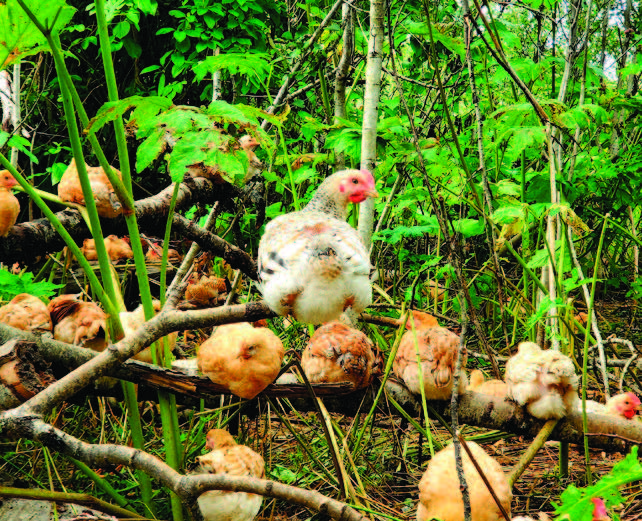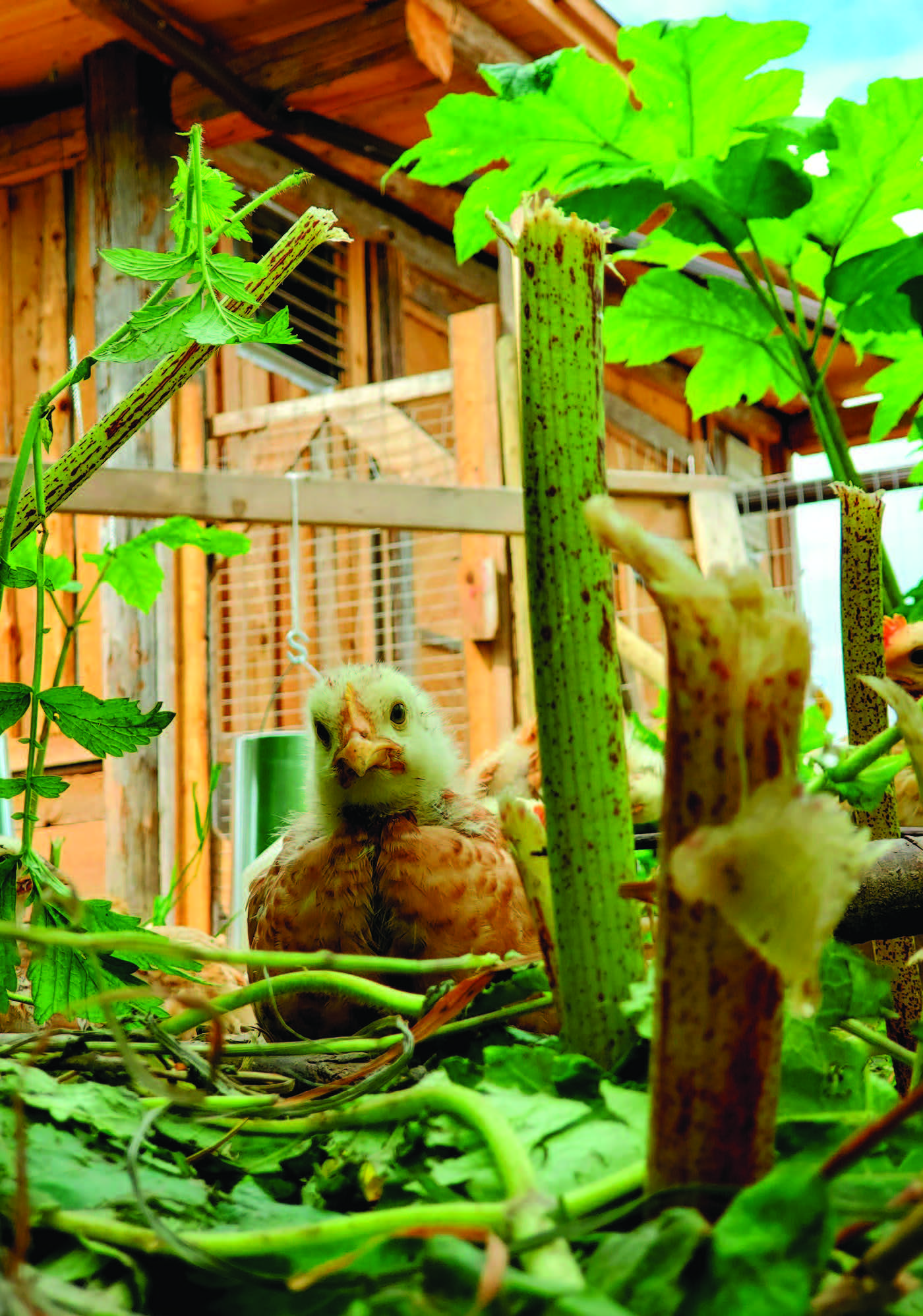I thought free-range chickens had the best—albeit short—life, but tree-range birds live the high life, and possibly the happiest life on the planet. At least when it comes to chickens. With so much stimulation from their surroundings, they spend a good part of the day playing. They bump chests and fake fight (no aggression) rather than the usual pecking at each other due to boredom or stress. Tree-rangers are mimicking the behaviours of their wild ancestors.

A Day in the Life
At the crack of dawn, the coop doors open and the flock moves into two paddocks treed with natural brush and at least 50 percent cover canopy. Here they are safe from overhead predators: they can hide and explore in foliage, forage and feed, rest and relax. (Most free-range chickens are put into open pastures with some overhead netting or guard dogs, which is stressful.)
Outside they are watered and fed with local grain, along with mineral and vitamin supplements. They get to range and play all day. The young birds run up and down the trails, flapping their wings like planes on airport runways. They rest in the shade and roost in lower branches of hazelnut and elderberry trees. And in the bush paddock they get to poke about alder, birch, spruce and wild hazelnut trees. They even have favourite comfy spots, depending on the paddock. Clearly, chickens know what makes them happy: shade and low branches, dirt and dust to bathe in, tiny sprouts and high-protein bugs to forage and munch on.

In the Beginning…
Tree-rangers have the non-profit Skeena Watershed Conservation Coalition (SWCC) to thank for the good life. “I got the Regenerative Poultry Project idea from a farmer in Minnesota who uses techniques he brought from Guatemala,” says Kesia Nagata, energy coordinator with SWCC. “He developed a chicken-rearing system that not only provides an income for farmers who can only afford a bit of land—it also regenerates the soil.” Poultry farming typically damages land by overuse, but these chickens (although not certified organic, they are grown without any additives, antibiotics, herbicides or pesticides) will be given unrestricted access to a series of rotating fenced-in grazing areas.
The SWCC’s project started in 2020 with 1,500 chickens on a small farm in the Upper Skeena, about 150 kilometers north of Terrace. Unfortunately, the Skeena flooded in June 2021 and wiped out the coop but most of the birds were rescued. As the water was rising the community rallied: residents put birds in wheelbarrows and totes, crates and buckets and evacuated them to nearby garages and outbuildings before moving them to two small farms.
Derek and Sophie Ingram were part of the rescue team: they took 400 birds to their farm in Hazelton.
“Too much stress kills birds, but this flock is tenacious,” says Derek. “They soon outgrew the farms—full-sized birds need one square foot each in the coop. My wife Sophie and I were planning on the Regenerative Poultry Project next year but within five days we built the infrastructure and had all the feed delivered.”
Derek “MacGyvered” shelter from old tin roofing but the interior was sweltering (birds create heat). They installed two huge fans in the coop so air circulated and only lost two birds under the heat dome. All in, about 20 birds out of the 400 didn’t make it, a survival rate which is amazing given industry standards.
But there is a downside: meat birds don’t have a long life— about 12 weeks. However, that’s about double the life span of industry chickens. They grow up so fast.
“Our birds are a heritage hybrid that grow slower. They aren’t as meaty but put on more weight. Industry birds just sit around eating, which is what they are designed to do. As for taste, the flavour is incomparable: yellow fat with more colour in the meat than industry poultry.”
Future Flocks
Like me, you probably want to know whether tree-range eggs are coming to our local market anytime soon. Kesia says the project’s goal is to feed communities of Upper Skeena with a focus on meat, at least for now. (Selling to the Smithers community is one of Derek’s long-term goals.) By selling direct via Facebook and word-of-mouth the first 1,500 chickens sold out. Derek is constructing a new paddock and barn for next year’s brood, another 1,500.
Kesia says the project itself is housed with SWCC, but is intended as a partnership/incubation with and for local farmers. Want to know more? Email admin@skeenawatershed.com and check out their Tree-Range Chicken Facebook page.

